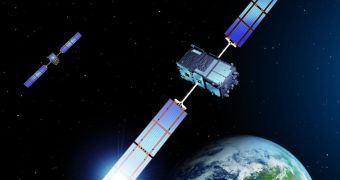According to officials at the European Space Agency (ESA), the first of four Galileo In-Orbit Validation (IOV) satellites is currently undergoing tests at the European Space Research and Technology Center (ESTEC), in the Netherlands.
This technical center is the primary analysis and technical center that the European organization operates, and it is directly responsible for handling most of the missions ESA develops.
The spacecrafts that ESTEC handles are either headed for other planets and moons, or are involved in space explorations, Earth-observation studies or satellite navigation. The new satellite currently being tested at the facility belongs in the last category.
Over the next two years, ESA will be launching 4 IOV satellites, which are meant to set the foundation of the Galileo satellite navigation system the organization is developing for the European Union.
The new network is being developed as an alternative to the American-built Global Positioning Systems (GPS), and will also feature global coverage, like its direct competitor. The EU decided to undergo this effort because of the limitations the US places on its data.
The American government does not allow civilians or other nations access to precise localization data. All readings available to the general public are therefore accurate within a certain degree of error.
But the data that the military receives is accurate to the inch, European officials say, and countries in the Union want access to similarly-reliable data as well. This is the main motivation behind Galileo.
Eventually, the satellite system will be extended to provide global coverage. After the IOV stage is completed, ESA will spend the next four years launching 18 navigation satellites. ESTEC will play a critical role in testing all the spacecraft before they take off.
“From the point of view of mechanical qualification, the Galileo IOV satellites are identical. So we are employing one of the satellites for this qualification testing, the first to be built, known as the Protoflight Model (PFM),” says expert Pedro Cosma.
“It will respond in practically the same way as the other Flight Models – FM2, FM3 and FM4,” he goes on to say. Cosma is the assembly integration and testing engineer for Galileo at ESTEC.
“We’re not anticipating any surprises. This is because we’ve previously carried out these tests on two Galileo structural/thermal models, but testing on an actual satellite remains an essential part of the official flight qualification process,” he concludes.

 14 DAY TRIAL //
14 DAY TRIAL //